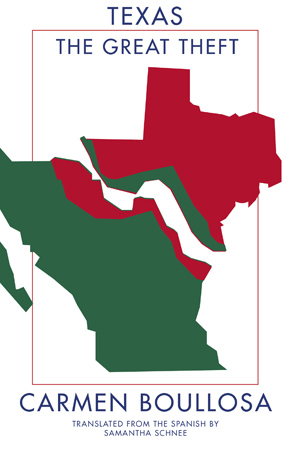A busybody’s brief note
by Carmen Boullosa
“Mexico’s greatest woman writer.” Roberto Bolaño
Let’s state it up front, so we don’t get muddled: this is the year 1859.
We’re on the northern and southern banks of the Río Bravo, known to some as the Rio Grande, in the cities of Bruneville and Matasánchez. Heading into the wind on horseback we could make it to the sea in half a morning.
Bruneville and Matasánchez call themselves cities, but you be the judge of whether they should be called towns.
I should tell you a few things about them: Bruneville is part of the state of Texas, Matasánchez is part of Mexico. The former (Bruneville) hasn’t been around long, only since ’21, when Mexico declared its independence.
That year, Mexico’s Far North was sparsely populated, though there were a few ranches scattered around – like the ones owned by Doña Estefanía which extend from the Nueces River all the way south to the Río Bravo – you’d have to ride four days to cross her lands from south to north.
Back then buffalo flourished. Mustangs ran free. Since the grasslands hadn’t been sown, you didn’t find cattle in herds; they grazed in twos or threes. But the Indians abounded, and they traveled in bands.
Indian Territory lay to the northeast, where the Apaches had lived since God created the Earth, and where a variety of northern tribes had moved, evicted from their homelands by the Americans, or fleeing from them. Since the Indians were so different (some were hunters and tanners, some farmers, some warriors), they didn’t share their territory in holy peace, no matter how similar we’d like to think they were.
The gringos responded to Mexico’s generosity by declaring their independence. They were motivated by their own interests, especially the right to own slaves.”
To protect their northern frontier from greedy Europeans and warlike Indians, the Mexican federal government invited Americans to live there. The government loaned them land or just gave it to them, sometimes even throwing in some livestock on certain conditions. To be perfectly clear: they made them sign contracts swearing to abide by the Catholic faith and pledge their allegiance to the Mexican government. However, they refused from the beginning to allow the importation of slaves, relenting only under great pressure, allowing a few in dribs and drabs.
In ’35 the gringos responded to Mexico’s generosity by declaring their independence. They were motivated by their own interests, especially the right to own slaves. The brand new (slaveholding) Republic of Texas declared its southern frontier to be the Nueces River.
At that time the sowing of the grasslands had begun – the grass seeds greedily hogging everything the earth had to offer – while acacias were burned down to make way for herds of livestock, which grazed and multiplied. The buffalo were decimated by hunters. The arrows of the hunter tribes frequently flew in vain, without finding targets.
It goes without saying that this was like a slap in the face to the Mexican government and made its landowners and ranchers hopping mad.
Then, in ’46, the Republic of Texas joined the United States, becoming the Lone Star State.
Immediately Texas claimed that its territories extended to the Río Bravo.
And you already know what happened after that. The Americans invaded us. In ’48, after the invasion (which they called the Mexican-American War, some nerve!), they declared that the Río Bravo was the official border. To stake their claim, the Texans founded Bruneville where previously there had been nothing but a dock built by the town of Matasánchez, “just in case”. Matasánchez became a border town.
Immigrants flooded into Bruneville from all over, some respectable folks, and some American lawyers determined to enforce the new laws, which meant shifting ownership of the land to the gringos. There were all kinds of crooks, the aforementioned, well-dressed ones who robbed (Mexicans) from behind their desks, as well as the kind who tied kerchiefs over their faces. And there were those who did a little of both.
It’s under these circumstances that our story takes place, at the time of the Great Theft.
Extracted from Texas: The Great Theft, translated by Samantha Schnee.
 Carmen Boullosa was born in Mexico City in 1954 and is one of Mexico’s leading novelists, poets and playwrights. She has published fifteen novels. Her works in English translation include They’re Cows, We’re Pigs; Leaving Tabasco; Cleopatra Dismounts; and Jump of the Manta Ray. Texas: The Great Theft is published by Deep Vellum. Read more.
Carmen Boullosa was born in Mexico City in 1954 and is one of Mexico’s leading novelists, poets and playwrights. She has published fifteen novels. Her works in English translation include They’re Cows, We’re Pigs; Leaving Tabasco; Cleopatra Dismounts; and Jump of the Manta Ray. Texas: The Great Theft is published by Deep Vellum. Read more.
Samantha Schnee is a founding editor and chairman of Words Without Borders, the online magazine of literary translation, former senior editor of Zoetrope: All-Story, and a translator from the Spanish.
Mika Provata-Carlone discusses Texas: The Great Theft and the power of Mexican literature.

